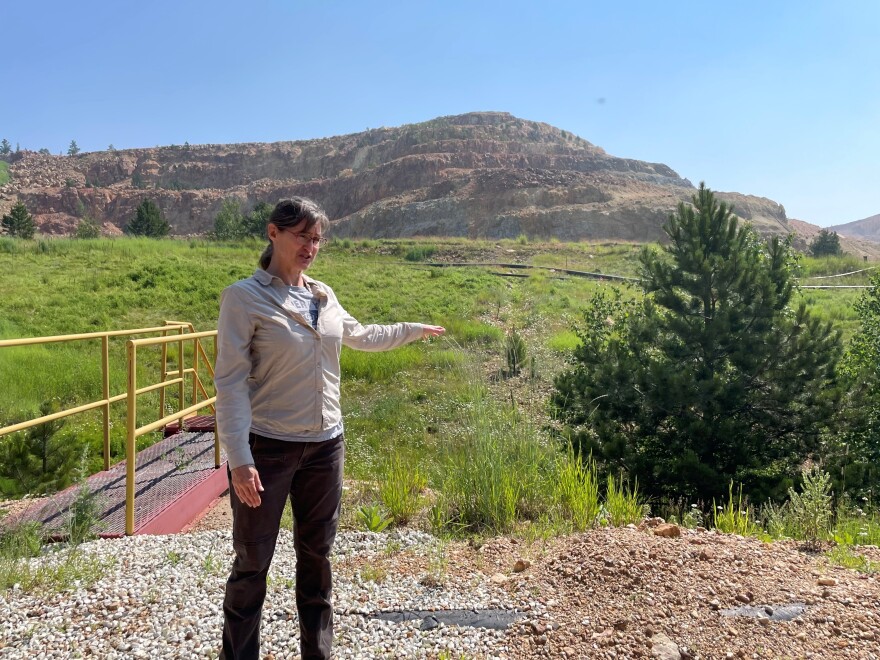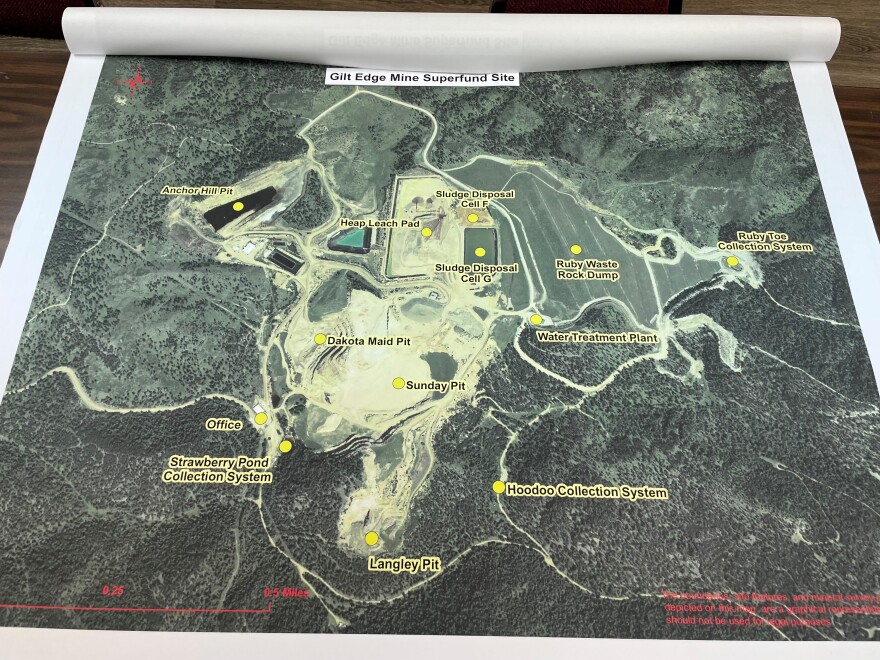On the western edge of a fenced-in field south of Lead, water flows out of a thick black tube down a ravine and into Strawberry Creek. This quarter-mile stretch of the waterway now functions as part of a complex filtration system.
Surface gold mining here exposed sulfuric rock that contaminates the water, making it harmful to fish. Even though this mine shut down decades ago, the caustic material must still be filtered before the water is reintroduced downstream.

To the east are remnants of the decades-old open pit surface mine left by the Brohm Mining Company. Giant stair steps of exposed rock, called ‘benches,’ contour the hillside.
“The benches are for safety, for catching rock as it falls," said Joy Jenkins, with the Environmental Protection Agency out of Denver.
The former mine is now a 1,000-acre superfund site. The area is fenced off and contains water contaminated with elevated levels of zinc, cadmium, nickel and copper. The EPA has managed the site for the last two decades.
“This is exposed rock that occurred during the mining days," Jenkins added, pointing to the east. "That exposure helps produce that acid mine drainage water that we address.”
The EPA pumps that contaminated water into large pits before filtering out the metals.
To date, the federal and state governments have spent more than $120 million to treat water and provide remediation to the site -- but that’s an old number. Jenkins said the efforts cost about $2 million annually.
The goal of the superfund site reclamation work is to cover the exposed rock with several feet of gravel, soil and vegetation.

But those efforts are on hold as gold producer Agnico Eagle considers reopening the Gilt Edge Mine. Brohm Mining abandoned the mine and declared bankruptcy when the price of gold fell about 20 years ago. Since then, the price of gold has recovered and occasionally hit record highs.
Agnico first started working the site in 2018. Earlier this year, the company drilled 40 new test holes to determine the minerals below the surface. Now, Agnico has an agreement with the EPA to drill even more.
A spokesperson for the company said they're interested in the Gilt Edge Mine site for two reasons.
“Based on some of the historical data at Gilt Edge there is reason to believe there is potential there for a mineable resource at Gilt Edge that’s still left," said Kwinn Neff, a community relations manager with Agnico Eagle. "Second, Agnico has a history of working with governments to find solutions for past legacy sites.”
The company points to its work reclaiming the Detour Lake Mine in Canada, another open pit mine the company acquired.
Neff said Agnico is aware of the acid mine drainage issue at Gilt Edge.
As part of the company’s initial investigation, Agnico is mapping the surface and underground locations of toxic rock. Neff says in the event the company reopens the Gilt Edge mine, that will allow it to better handle toxic drainage.
He called removing that cost burden from federal and state taxpayers a win-win.

As of last month, Agnico is now covering the annual $2 million cost of water treatment for the duration of a four-year agreement with the EPA.
Some area residents are hesitant about the prospect of re-opening the mine.
“I’m very concerned about the future of that,” said Rick Bell, who lives in Rapid City. Bell is a retired environmental engineer and a member of the group Dakota Rural Action, a grassroots conservation group.
Bell said additional mining can lead to more exposure of sulfuric rock, which caused the acid water contamination to begin with.
“When the state allowed Brohm to start mining there again—and it’s an historic site, but—they knew that all that pyrite was there. They knew that they were going to have an acid mine drainage problem from any future mining," Bell said. "That hasn’t changed.”
Agnico Eagle has already spent $1.5 million to investigate what’s in the underground ore deposits. Between that, and taking on the cost of cleanup, some worry that means a return to active mining.
However, the project isn’t even mentioned in the company’s most recent annual report. Agnico Eagle said it generated $1.5 billion in revenue for the first quarter of 2023.
“The amount of money that Agnico has invested in the Gilt Edge is a pittance," said Mark Bowron, a professor of mining engineering and management at South Dakota Mines. “It’s not terribly significant in their overall exploration budget for a year.”
Bowron said Agnico’s exploration of the Gilt Edge site is part of a strategy of gold exploration where companies have multiple projects in the pipeline. As an example, Bowron said, Agnico might have 100 exploration projects, but only take ten to the next level.
“Out of that ten, one might become a producing mine," Bowron added. "That’s the kind of risk we’re talking about.”
Bowron, who is a shareholder in Agnico, said reopening Gilt Edge is far from a done deal.
But that all depends on what’s found underground in the next few years.
Meanwhile, the state of South Dakota is working with the federal government to transfer ownership of the remaining 266 acres of the 1,000-acre superfund site from the forest service to the state.
Officials said that will allow the state to quickly perform any remediation needed in the future, without having to wait for federal approval.
In the event the mine is reopened the state would collect a two percent royalty on any gold recovered from the property.


